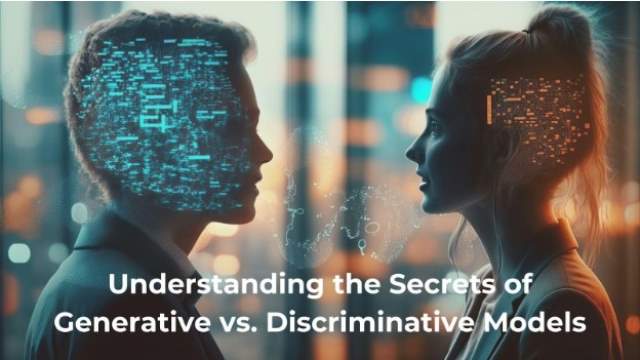Understanding the Secrets of Generative vs. Discriminative Models
Introduction
Modern artificial intelligence’s success depends on machine learning models, which through data-driven techniques can make decisions or predictions without any explicit rules. There are two main types of these models: the generative and discriminative models. On the other hand, generative models try to understand and model (P, X, Y) which is a joint probability distribution of input features and output labels in order to generate new data points. They include Generative Adversarial Networks (GANs) and Gaussian Mixture Models (GMMs). Conversely, discriminative models aim at learning the conditional probability distribution directly P(Y|X), which helps in separating various classes. Examples of discriminative models are logistic regression and support vector machines (SVM).
Knowing how to select an appropriate method for a given task requires an understanding of these differences between generative and discriminative approaches. For example, generative models are good at generating data or detecting anomaly while discriminative ones perform better in classification or regression problems because they pay attention to decision boundaries. Thus, being aware of these disparate qualities will help one gain maximum advantage from specific model types depending on their problem contexts thereby enhancing efficiency as well as overall performance in machine learning applications.
Understanding Generative Models
Generative models are a class of machine learning models that seek to learn the probability distribution P (X, Y) for input data X and output labels Y. These generative models can create new points from the learned dataset samples with such features that make them vital tools for augmenting and synthesizing data.
To capture the underlying patterns and structures within the data, generative models learn joint probability distribution P (X, Y), which indicates how likely certain combination of a specific pair of input features and output labels is. The learning process includes estimating the distribution of input data and conditional distributions of outputs given inputs.
Examples of Generative Models:
- Gaussian Mixture Models (GMM): These comprise several Gaussian distributions representing different clusters or components in the data set.
- Hidden Markov Models (HMM): HMMs model sequences of observed events based on underlying hidden states and determine their probabilities.
- Naive Bayes Classifiers: These probabilistic classifiers assume that features are independent by using Bayes’ theorem as starting point.
- Variational Autoencoders (VAEs): VAEs are deep learning architectures that model a latent variable representation for data allowing generation of new instances through sampling from latent space.
- Generative Adversarial Networks (GANs): GANs combine two separate neural networks– one being a generator while another being discriminator- into an adversarial system with each trying to outdo the other one. The generator comes up with fake examples while the discriminator determines whether they are true leading to highly realistic examples.
Applications Of Generative Models:
- Image and Text Generation: Some generative models can generate realistic images, come up with coherent text or even develop art such as GANs and VAEs.
- Anomaly Detection: Anomalies refer to cases where points do not fit learned distribution since they model what normal data looks like.
- Data Augmentation: In cases where there is very limited data, generative models can produce extra training data by generating new samples.
Understanding Discriminative Models
Discriminative models are one type of machine learning model that concentrates on the conditional probability distribution P(Y|X), in which Y represents output labels and X denotes input features. They work by directly separating different classes, thus making them good choices for tasks such as classification and regression.
Discriminative models learn the boundary between various classes with respect to a given input data. Instead of modeling the whole distribution of input data, they focus only on the relationship between inputs and outputs to optimize class separation. This implies that discriminative model is more straightforward and usually provides better performance for classifying or predicting outputs based on inputs.
Examples of Discriminative Models:
- Logistic Regression: A statistical model for binary classification tasks that predicts probability of an input belonging to a particular class.
- Support Vector Machines (SVM): These models search for optimum hyperplane maximizing margin between different classes in an input feature space.
- Decision Trees: Models use tree-like structures to perform decisions depending upon input features, dividing the data at each node according to value of some feature.
- Random Forests: It is an ensemble method combining several decision trees to increase predictions’ robustness and accuracy.
- Neural Networks (including Convolutional Neural Networks): Complex models consisting of multiple layers of interconnected nodes (neurons) capable of discovering intricate patterns within data. Specifically, Convolutional Neural Networks (CNNs) are designed for structured grid data processing like images.
Applications of Discriminative Models:
- Classification Tasks: Tasks such as spam detection, image classification, sentiment analysis requires discriminant models since they provide a way to assign certain inputs among a number or predefined categories.
- Regression Tasks: Likewise, these are also used when predicting continuous values like house prices or stock market trends which are represented as a numerical value rather than a category
- Object Detection: In computer vision, discriminant models like CNNs identify and localize objects in images, which is very useful for applications like autonomous driving and facial recognition.
Key Differences Between Generative and Discriminative Models
| Category | Generative Models | Discriminative Models |
| Approach to Modeling Data | Models the joint probability P (X, Y) | Models the conditional probability P(Y) |
| Data Representation and Complexity | Requires modeling the distribution of input data (X) and the relationships with outputs (Y) | Focuses on the boundary between different classes without modeling the distribution of input data |
| Performance in Tasks | Typically, better for tasks requiring data synthesis or anomaly detection | Often superior in tasks requiring precise classification or regression |
| Training Complexity | It can be more complex and computationally intensive due to the need to model the entire data distribution | Generally simpler to train, focusing only on the classification boundary |
| Flexibility | Capable of generating new data points like the training data | Primarily focuses on decision boundaries; less flexible in generating new data points |
| Interpretability | May provide insights into the structure and distribution of the data | Easier to interpret for classification tasks, as they provide direct decision boundaries |
| Robustness to Overfitting | Often more prone to overfitting due to the complexity of modeling entire data distributions | Generally, less prone to overfitting, especially when regularization techniques are applied |
| Examples | Gaussian Mixture Models, Hidden Markov Models, Naive Bayes classifiers, Variational Autoencoders, GANs | Logistic Regression, Support Vector Machines, Decision Trees, Random Forests, Neural Networks (including CNNs) |
| Applications | Image and text generation, anomaly detection, data augmentation | Spam detection, image classification, regression tasks, object detection |
| Bayesian Perspective | Involves both priors and likelihoods (P (X)) | (Y) and P(Y) |
| Bias-Variance Trade-Off | May have higher variance due to modeling more complex distributions | Often has lower variance and is more robust to overfitting in certain contexts |
| Information Theory Perspective | Can capture more information about the data distribution | Optimizes information specific to classification or prediction tasks |
Practicality Considerations
When to Choose Generative Models:
- Generation of New Data: In situations where synthetic data is required for training, generative models are the best approach. For example, Variational Autoencoders (VAEs) and Generative Adversarial Networks (GANs) can be used to create images or texts that resemble actual ones when you have limited data.
- Complex Dependencies: These models can be employed in cases where input features and outputs have complex dependencies. Hidden Markov Models (HMMs), for instance, are widely used in speech recognition to model sequential data with underlying hidden states.
- Anomaly Detection: Good at learning the normal distribution of a dataset and then identifying any deviations from it. This works well in fraud detection or checking for faults within industrial systems which do not occur often but are serious in their effects.
When to Choose Discriminative Models:
- Standard Classification and Regression Tasks: For general tasks like spam detection, image classification or predictive analytics, discriminative models fit perfectly into it. Generally, Logistic Regression, Support Vector Machines (SVMs), mostly because they have high accuracy and are easy to implement.
- Predictive Accuracy and Simplicity: The focus on simplicity and high predictive accuracy makes discriminative modelling a preferred choice. The direct modelling of the decision boundary by discriminant models ensures their ease of implementation, providing reassurance to the audience about their simplicity.
- Real-Time Applications: The lower computational complexity of discriminative models is a significant advantage, making them ideal for applications requiring fast inference. This efficiency is particularly beneficial for real-time tasks such as object detection in autonomous vehicles or live sentiment analysis, instilling confidence in the choice of discriminative models.
Hybrid Approaches and Advanced Models
Introduction to Hybrid Models
Considering the benefits of each model, hybrid models combine the strengths of both generative and discriminative approaches. They aim to improve the overall performance and robustness of models by integrating the capabilities of generative models in understanding data distributions with the proficiency of discriminative models in classification tasks.
Examples of Hybrid Models:
- Semi-Supervised Learning Models: These types of learning use a few known training cases and many unknown cases to improve learning efficiency. Discriminative modeling can be enhanced by generative modeling, which generates synthetic data for training.
- GANs with Discriminators: Generative Adversarial Networks (GANs) is an example where one model, called the generator, generates new instances while another model called the discriminator, rates them depending on how realistic they seem. This co-training improves the quality of generated data, which is helpful in applications such as image synthesis and style transfer.
Benefits of Hybrid Approaches:
- Leveraging Strengths: For instance, hybrid models utilize generative models’ capability to understand and generate data distributions while exploiting discriminative models’ accuracy in classification and regression tasks.
- Improved Robustness and Performance: Combining both approaches enables hybrid models to perform better across a wider range of tasks. Such situations often involve situations where either limited labeled data or complex dependencies must be modeled; hence, they generalize well into different areas.
Conclusion
Generative models can learn the joint probability distribution P (X, Y) as they are used in data generation, anomaly detection, and applications with complex dependencies. On the other hand, discriminative models mainly focus on conditional probability P (Y|X) and hence excel in classification, regression, and real-time applications due to their simplicity and accurate prediction. Depending on whether the requirements of each case involve generating new data or improving classification accuracy, one will opt for a good model.
Future advances would probably move towards hybrid models that combine these two approaches, taking advantage of generative power for data augmentation and discriminative precision for prediction, thereby enhancing machine learning systems’ resilience and efficiency. By integrating both methods, we could create more adaptable AI systems.







